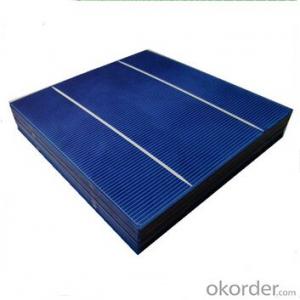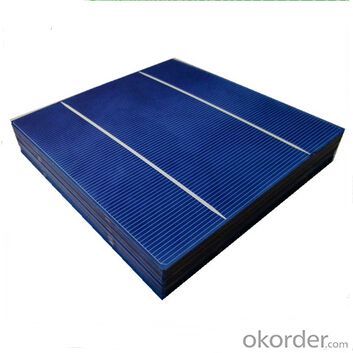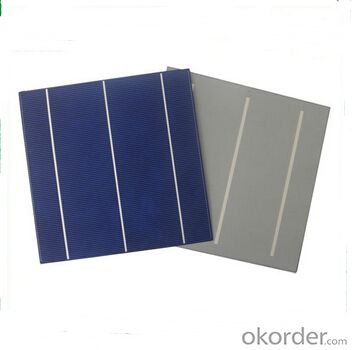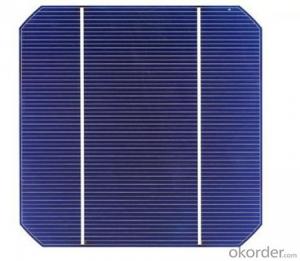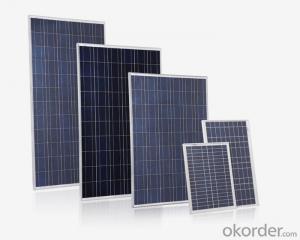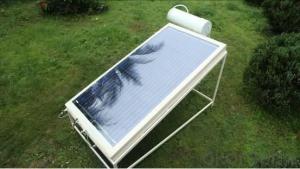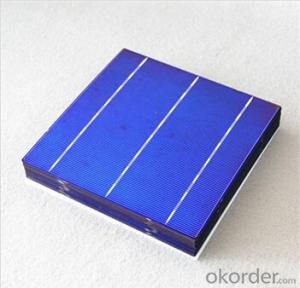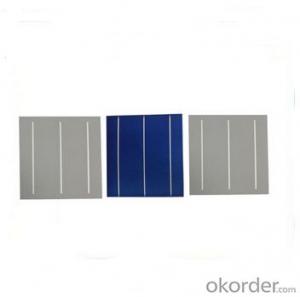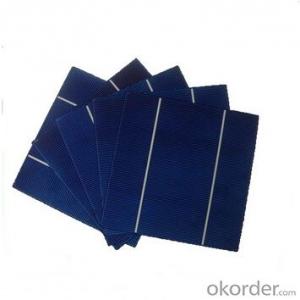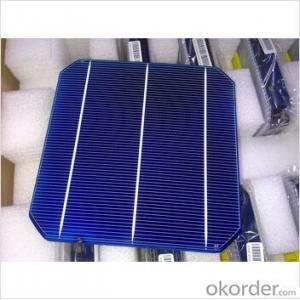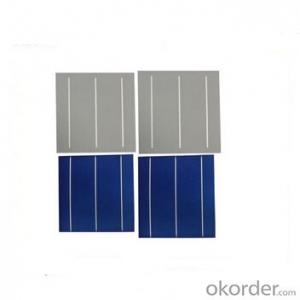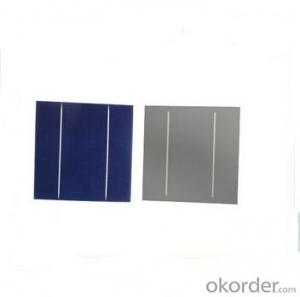Evergreen Solar Cells Polycrystalline High Quality 180µm ±20µm
- Loading Port:
- Shanghai
- Payment Terms:
- TT OR LC
- Min Order Qty:
- 1000 pc
- Supply Capability:
- 1000000 pc/month
OKorder Service Pledge
OKorder Financial Service
You Might Also Like
Solar Cells:
Solar cells is made by solar wafer, it has three categories of solar cell right now, monocrystalline polycrystalline and thin film,These cells are entirely based around the concept of PN junction, which is the critical part of solar module, it is the part that can convert the light energy into electricity, the thickness is from 180um to 200um, with even busbars to conduct electricity, textured cell can decrease diffuse reflection; they are often electrically connected and encapsulated as a module. Photovoltaic modules often have a sheet of glass on the front (sun up) side, allowing light to pass while protecting semiconductor wafers from abrasion and impact due to wind-driven debris, rain, hail, etc. Solar cells are also usually connected in series in modules, creating an additive voltage. Connecting cells in parallel will yield a higher current;With high quality and stable quality. Our Cells can greatly improve the performance of Solar Modules.
Solar Cells Advantage:
• High efficiency and stable performance in photovoltaic conversion.
• Advanced diffusion technique ensuring the homogeneity of energy conversion efficiency of the cell.
• Advanced PECVD film forming, providing a dark blue silicon nitride anti-reflection film of homogenous color and attractive appearance.
• High quality metal paste for back surface and electrode, ensuring good conductivity, high pulling strength and ease of soldering.
• High precision patterning using screen printing, ensuring accurate busbar location for ease with automatic soldering a laser cutting.
Specifications
Dimension | 156mmx156mm±0.5mm |
Thickness(Si) | 180µm ±20µm, 200µm±20µm |
Front | Blue silicon nitride anti-reflective coatings 1.4mm silver busbar |
Back | Full-surface aluminum back-surface field 2.5mm(silver/aluminum discontinuous soldering pads |
Features | |
> High conversion efficiences resulting in superior power output performance | |
> Outstanding power output even in low light or high temperature conditions | |
> Optimized design for ease of soldering and lamination | |
> Long-term stability,reliability and performance | |
> Low breakage rate | |
> Color uniformity | |
Production and Quality Control | |
> Precision cell efficiency soring procedures | |
> Stringent criteria for color uniformity and appearance | |
> Reverse current and shunt resistance screening | |
> REACH-SVHC test passed, IS09001,ISO14001 and OHSAS 18001certificated | |
> Calibrated against Fraunhofer ISE | |
Features:
High efficiencies up to 16.4%
Proven long term mechanical stability of silicone
Make of highly purified poly silicone
Three bus bars for reduced series resistance and improved module and cell efficiency
Blue anti-reflecting coating ensures improved light absorption and increased efficiency
Acid texturization offers a uniform appearance and virtually invisible crystal structure
Excellent low light behavior for improved energy yield
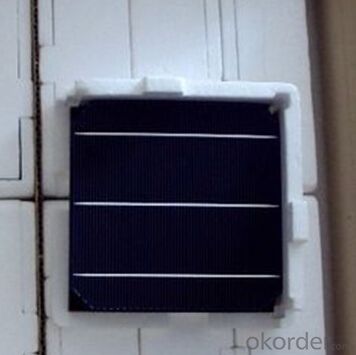
FAQ
We have organized several common questions for our clients,may help you sincerely:
①What price for each watt?
It depends on the efficiency of the solar cell, quantity, delivery date and payment terms.
②How long can we receive the product after purchase?
In the purchase of product within three working days, We will arrange the factory delivery as soon as possible. The pecific time of receiving is related to the state and position of customers.Commonly 7 to 10 working days can be served.
③Can you provide the peripheral products of the solar panels, such as the battery, controller, and inverter? If so, can you tell me how do they match each other?
Yes, we can, we have two companies for solar region, one is CNBM International, the other is CNBM engineering Co.
We can provide you not only the solar module but also the off grid solar system, we can also provide you service with on grid plant.
④What is your warranty of solar cell?
Our product can promise lower than 0.3% open box crack, we support claim after opening the box if it has crackm color difference or sth, the buyer should give pictures immediately, we can not accept the claim after the solar cell has assembled to solar panel.
• Timeliness of delivery
• ⑤How do you pack your products?
We have rich experience on how to pack the solar cell to make sure the safety on shipment, we could use wooden box or pallet as buyer's preference.
- Q: How do solar cells perform in cloudy or overcast conditions?
- Solar cells are less efficient in cloudy or overcast conditions compared to direct sunlight. Cloud cover reduces the amount of sunlight reaching the solar cells, resulting in decreased electricity production. However, solar cells can still generate some energy in these conditions, although at a reduced rate.
- Q: How does the solar cell work in terms of photochemical conversion?
- If impurities are incorporated into the true semiconductors, i.e. monocrystalline silicon, for example, incorporation of pentavalent phosphorus (P), excess electrons are called, which are called N-type semiconductors.
- Q: Can solar cells be damaged by hail or other weather conditions?
- Yes, solar cells can be damaged by hail or other severe weather conditions. Hailstones or strong winds can cause physical damage to the surface of solar panels, leading to cracks or breakages. Additionally, extreme heat or cold can affect the efficiency and lifespan of solar cells. Therefore, it is important to consider the weather conditions and install appropriate protection measures to safeguard solar panels.
- Q: Can solar cells be used in public charging stations for electric vehicles?
- Yes, solar cells can be used in public charging stations for electric vehicles. By harnessing solar energy, these charging stations can provide clean and renewable power to charge electric vehicles, reducing reliance on traditional grid electricity and contributing to a more sustainable transportation system.
- Q: Can solar cells be used in vehicles?
- Yes, solar cells can be used in vehicles. They are commonly used in electric vehicles (EVs) to charge the battery and provide power to various systems, increasing their range and efficiency. Solar panels can be installed on the roof or hood of a vehicle to capture sunlight and convert it into electricity, helping to reduce reliance on grid charging and decrease carbon emissions.
- Q: Can solar cells be used in public transportation systems?
- Yes, solar cells can be used in public transportation systems. They can be installed on the roofs of buses, trains, and trams to generate electricity from sunlight, which can be used to power various systems such as lighting, air conditioning, and onboard electronics. This helps reduce reliance on fossil fuels and lowers the carbon footprint of public transportation. Additionally, solar cells can also be integrated into bus shelters and charging stations to provide clean energy for electric buses and other vehicles.
- Q: Can solar cells be used in powering irrigation systems?
- Yes, solar cells can be used to power irrigation systems. Solar panels can convert sunlight into electricity, which can then be used to power pumps and other components of an irrigation system. This is a sustainable and cost-effective solution, especially in areas with abundant sunlight, as it reduces the dependency on traditional energy sources and can provide a reliable source of power for irrigation.
- Q: Can solar cells be used to power remote oil and gas monitoring systems?
- Yes, solar cells can be used to power remote oil and gas monitoring systems. Solar panels can convert sunlight into electricity, providing a reliable and sustainable energy source for these monitoring systems, especially in remote areas where access to traditional power grids may be limited or non-existent.
- Q: How much energy can a solar cell produce?
- The amount of energy a solar cell can produce largely depends on its size, efficiency, and the amount of sunlight it receives. On average, a typical solar cell can convert around 15-20% of sunlight into usable electricity. Therefore, the energy production can vary, but a single solar cell can typically generate up to a few watts of power.
- Q: Are solar cells affected by temperature changes?
- Yes, solar cells are affected by temperature changes. As the temperature increases, the efficiency of solar cells decreases. This is because higher temperatures can cause an increase in the electron-hole recombination rate, leading to a reduction in the generation of electricity. Conversely, lower temperatures can improve the performance of solar cells by reducing thermal losses. However, extreme temperature changes can also cause stress and potential damage to the cells, so maintaining a moderate operating temperature is important for optimal performance.
Send your message to us
Evergreen Solar Cells Polycrystalline High Quality 180µm ±20µm
- Loading Port:
- Shanghai
- Payment Terms:
- TT OR LC
- Min Order Qty:
- 1000 pc
- Supply Capability:
- 1000000 pc/month
OKorder Service Pledge
OKorder Financial Service
Similar products
Hot products
Hot Searches
Related keywords
